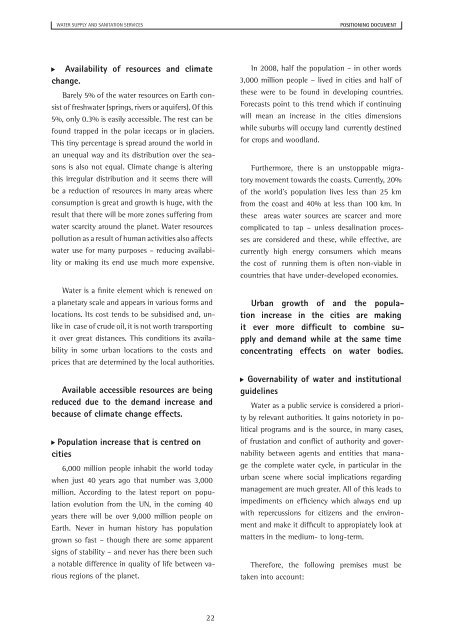Servicios de Abastecimiento y Saneamiento - La Tribuna del Agua
Servicios de Abastecimiento y Saneamiento - La Tribuna del Agua
Servicios de Abastecimiento y Saneamiento - La Tribuna del Agua
You also want an ePaper? Increase the reach of your titles
YUMPU automatically turns print PDFs into web optimized ePapers that Google loves.
WATER SUPPLY AND SANITATION SERVICES<br />
Availability of resources and climate<br />
change.<br />
Barely 5% of the water resources on Earth con-<br />
sist of freshwater (springs, rivers or aquifers). Of this<br />
5%, only 0.3% is easily accessible. The rest can be<br />
found trapped in the polar icecaps or in glaciers.<br />
This tiny percentage is spread around the world in<br />
an unequal way and its distribution over the sea-<br />
sons is also not equal. Climate change is altering<br />
this irregular distribution and it seems there will<br />
be a reduction of resources in many areas where<br />
consumption is great and growth is huge, with the<br />
result that there will be more zones suffering from<br />
water scarcity around the planet. Water resources<br />
pollution as a result of human activities also affects<br />
water use for many purposes – reducing availabi-<br />
lity or making its end use much more expensive.<br />
Water is a finite element which is renewed on<br />
a planetary scale and appears in various forms and<br />
locations. Its cost tends to be subsidised and, unlike<br />
in case of cru<strong>de</strong> oil, it is not worth transporting<br />
it over great distances. This conditions its availability<br />
in some urban locations to the costs and<br />
prices that are <strong>de</strong>termined by the local authorities.<br />
Available accessible resources are being<br />
reduced due to the <strong>de</strong>mand increase and<br />
because of climate change effects.<br />
Population increase that is centred on<br />
cities<br />
6,000 million people inhabit the world today<br />
when just 40 years ago that number was 3,000<br />
million. According to the latest report on popu-<br />
lation evolution from the UN, in the coming 40<br />
years there will be over 9,000 million people on<br />
Earth. Never in human history has population<br />
grown so fast – though there are some apparent<br />
signs of stability – and never has there been such<br />
a notable difference in quality of life between va-<br />
rious regions of the planet.<br />
22<br />
POSITIONING DOCUMENT<br />
In 2008, half the population – in other words<br />
3,000 million people – lived in cities and half of<br />
these were to be found in <strong>de</strong>veloping countries.<br />
Forecasts point to this trend which if continuing<br />
will mean an increase in the cities dimensions<br />
while suburbs will occupy land currently <strong>de</strong>stined<br />
for crops and woodland.<br />
Furthermore, there is an unstoppable migratory<br />
movement towards the coasts. Currently, 20%<br />
of the world’s population lives less than 25 km<br />
from the coast and 40% at less than 100 km. In<br />
these areas water sources are scarcer and more<br />
complicated to tap – unless <strong>de</strong>salination processes<br />
are consi<strong>de</strong>red and these, while effective, are<br />
currently high energy consumers which means<br />
the cost of running them is often non-viable in<br />
countries that have un<strong>de</strong>r-<strong>de</strong>veloped economies.<br />
Urban growth of and the population<br />
increase in the cities are making<br />
it ever more difficult to combine supply<br />
and <strong>de</strong>mand while at the same time<br />
concentrating effects on water bodies.<br />
Governability of water and institutional<br />
gui<strong>de</strong>lines<br />
Water as a public service is consi<strong>de</strong>red a priori-<br />
ty by relevant authorities. It gains notoriety in po-<br />
litical programs and is the source, in many cases,<br />
of frustation and conflict of authority and gover-<br />
nability between agents and entities that mana-<br />
ge the complete water cycle, in particular in the<br />
urban scene where social implications regarding<br />
management are much greater. All of this leads to<br />
impediments on efficiency which always end up<br />
with repercussions for citizens and the environment<br />
and make it difficult to appropiately look at<br />
matters in the medium- to long-term.<br />
Therefore, the following premises must be<br />
taken into account:


